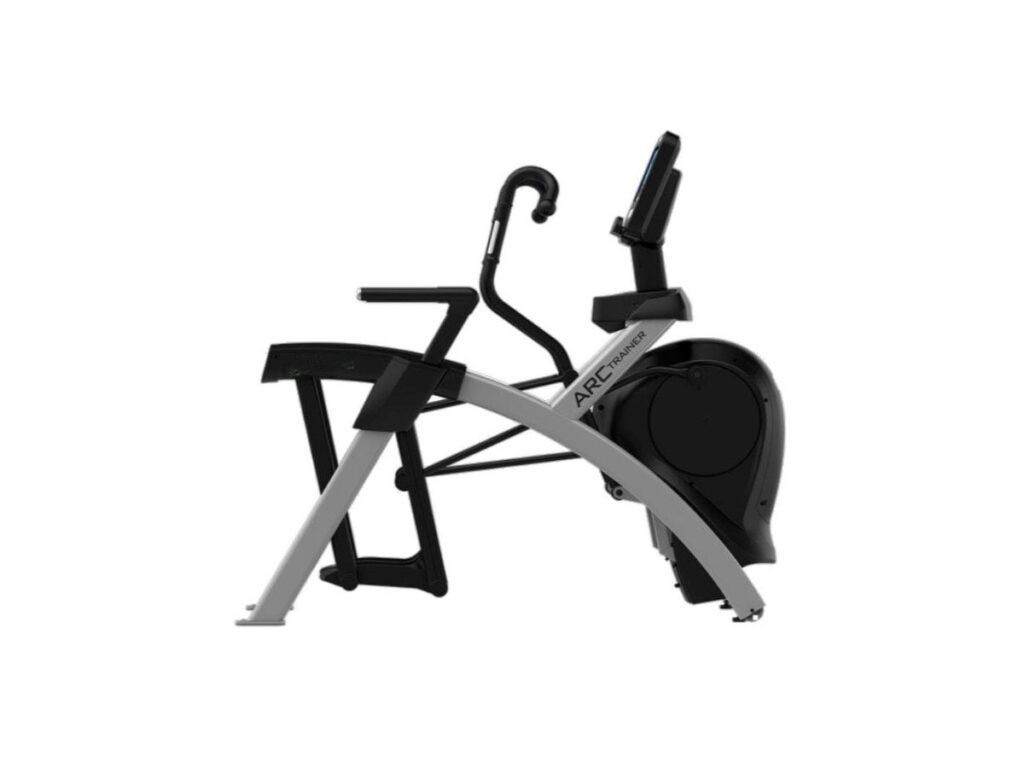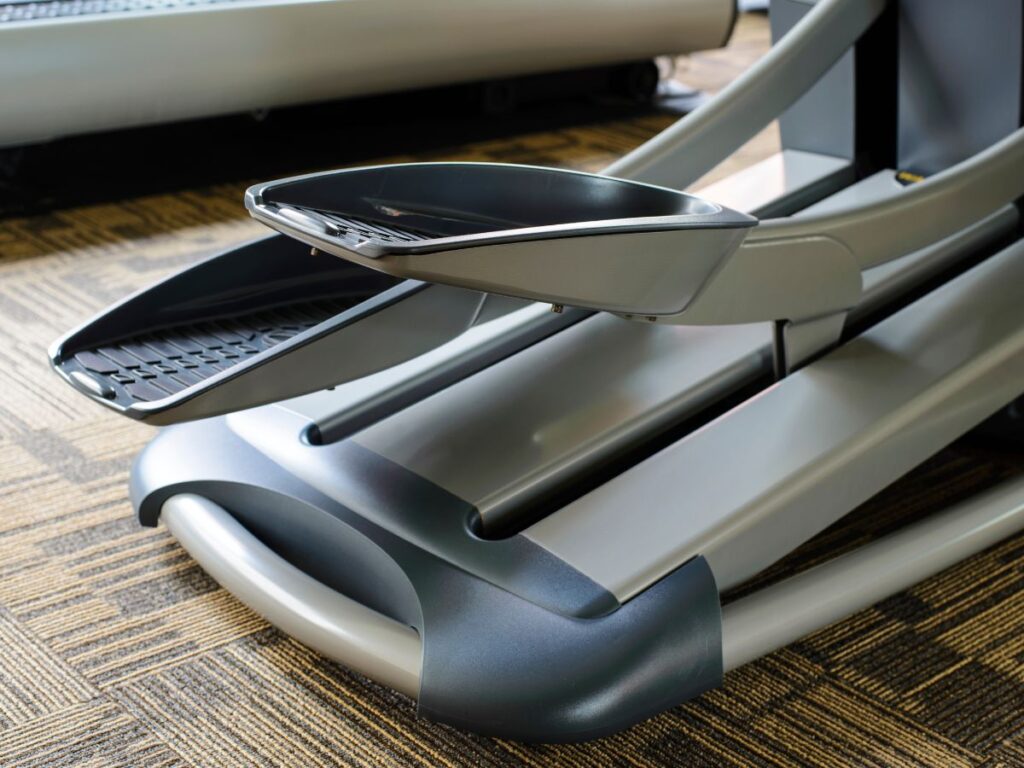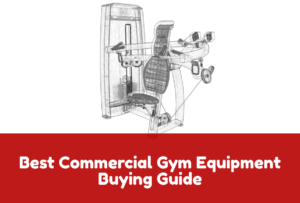When I first opened my gym, I assumed all cardio machines worked the same.
I chose equipment based on looks, not function thinking they’d all burn calories equally. I’ve learned a lot since then.
If you’re deciding between an arc trainer and a cross trainer, this article is for you. I’ll walk you through how each machine works, who benefits most from each, and how to choose the right one for your gym.
By the end, you’ll know exactly how to tell them apart—and which one fits your space best.
Let’s get started!
Table of Contents
1. What is Arc Trainer?
When I added my first arc trainer to the floor, I wasn’t sure it would stand out. But over time, it became one of the most used machines by older members and athletes in rehab. That’s when I started paying attention.
The arc trainer is a low-impact cardio machine built to reduce joint stress. It follows an arc-like path, which puts less strain on knees, hips, and ankles compared to a treadmill or stair stepper.
The movement feels like a blend of:
- A stepper
- An elliptical
- A ski machine
But with better control and less pressure on the body.
Key Features
- Adjustable Incline: Can shift the incline angle to target different muscle groups. Lower inclines focus on glutes, while higher ones hit quads and hamstrings harder.
- Variable Resistance: Resistance settings let users switch from light cardio to more strength-based sessions. This adds flexibility to training programs.
- Arc Motion Path: The stride path follows a curved motion, not a circle. It’s more natural and easier on joints, especially for users dealing with knee or hip issues.
- Muscle Targeting: Designed to emphasize lower-body engagement, can get consistent work in the glutes, quads, and hamstrings.
Who It Works Best For
Arc trainers are often a smart fit if your gym serves:
- Athletes in recovery
- Older members needing low-impact options
- Anyone avoiding machines that strain the joints
Do you get requests for gentler cardio machines that still offer results?
If yes, the arc trainer is a solid addition to your gym.

Upgrade your cardio zone with commercial-grade Arc Trainers built for low-impact, versatile training—connect with YR Fitness to discuss your equipment needs.
2. What is Cross Trainer?
A cross trainer—also known as an elliptical trainer—is a cardio machine designed to mimic walking, running, or stair climbing. But unlike treadmills, it removes the impact. The pedals glide in an elliptical (oval-shaped) path that keeps both feet in contact with the machine at all times, especially when engineered for smooth performance by a reputable commercial gym equipment manufacturer.
This design lowers stress on joints while still offering a full-body workout. It works the legs, arms, and core all at once.
Key Features
- Dual Action Handles: Handles move with the pedals, engaging the upper body. This allows users to work both arms and legs in one motion.
- Elliptical Stride Motion: The stride path is smooth and circular. It feels natural and steady, helping with balance and rhythm.
- Resistance and Speed Settings: Users can adjust resistance and speed to match their fitness level or workout goal—whether that’s steady-state cardio or intervals.
- Full-Body Activation: Cross trainers engage more than just the lower body. With proper form, users can target arms, shoulders, and back too.
Who It Works Best For
This machine fits most fitness levels and goals. It’s a go-to for:
- General cardio users
- Beginners
- Weight-loss clients
- People who want to avoid running
Have you noticed members choosing one machine over others just because it feels “easy to use”?
That’s the cross trainer in action.
I’ve watched it become a comfort zone for many—and sometimes, comfort is what keeps people coming back.

Cross trainers are a smart choice for gyms that want low-impact cardio machines members actually love to use. At YR Fitness, we build commercial-grade cross trainers designed for smooth motion, durability, and full-body engagement. Talk to us today and let’s choose the right models to keep your members moving—and your gym ahead of the curve.
3. Biomechanics & Motion Path
One thing that surprised me early on was how different two machines could feel—even when they look similar. The arc trainer and cross trainer are a perfect example of that.
Let’s break down how they move and how it affects your members’ bodies.
Arc Trainer Motion
The arc trainer moves in a linear arc pattern. That means the pedals glide forward and slightly upward, creating a gentle arc.
It doesn’t feel like walking or running. It feels like gliding with control. No hard impact, no bounce.
This arc motion keeps the hips, knees, and ankles in a more neutral position. That makes it a solid option for people managing joint pain or rehabbing an injury. The arc trainer also shifts body weight in a way that focuses more on the lower body. It’s a great tool when the goal is to reduce stress but keep intensity.
Cross Trainer Motion
The cross trainer follows an elliptical path—a continuous, oval-shaped stride. This mimics natural walking or running, but without foot impact.
It’s smooth. It’s steady. And it offers a bit more upper-body rhythm thanks to the moving handles.
If your members are used to walking outdoors or running on treadmills, this motion often feels more familiar. They don’t need to relearn how to move.
Impact on Joint Health
If you serve rehab patients or older clients, the arc trainer is often the better fit.
If your members just want a joint-friendly cardio option with full-body movement, the cross trainer holds its own.
So ask yourself: Who’s using your machines most? That answer may guide what you prioritize on your floor.
Arc or cross trainer, the right biomechanics mean safer workouts and happier members. YR Fitness engineers commercial cardio machines to support natural movement and reduce joint stress. Talk to us to choose the best fit for your facility and training programs.
4. Performance & Workout Capabilities
A client once told me they had just 25 minutes to work out. They asked, “Which machine gives me the most for my time?” That’s when I really started comparing arc trainers and cross trainers by the numbers—not just feel.
Calorie Burn & Intensity Options
The arc trainer is known for its efficiency. Users can burn up to 475–600 calories in 30 minutes, depending on body weight and intensity. That’s around 950–1,200 calories per hour. The arc motion hits larger muscle groups harder, and users feel less strain—so they can go all out without tiring as quickly.
Cross trainers burn about 400–500 calories per 30 minutes, or 800–1,000 per hour, based on speed and resistance. The full-body motion spreads the effort, which makes it great for longer cardio sessions.
If your members are primarily focused on weight loss, both machines can help—but each has unique strengths to consider.
Muscle Targeting
Arc Trainer is adjustable incline lets users shift focus:
- Lower Incline: Glutes
- Middle Incline: Quads
- Higher Incline: Hamstrings
This helps isolate specific muscle groups more directly—especially during strength-cardio routines.
However, cross Trainer targets both upper and lower body evenly. Users get balanced engagement, but without the deeper isolation the arc provides.
Workout Versatility
Arc Trainer fits well into:
- High-intensity interval training (HIIT)
- Strength-cardio hybrid workouts
- Post-rehab conditioning
Cross Trainer is ideal for:
- Steady-state cardio
- Warm-ups and cooldowns
- LISS (low-intensity steady state) cardio
If your members want quick calorie burn with more muscle focus, the arc trainer wins. If they’re after long, full-body sessions with a steady rhythm, the cross trainer gets the job done.
Either way, having both means you’re covered.

Whether your members want fast fat-burn sessions or smooth endurance workouts, YR Fitness builds commercial machines designed for real performance. Contact us to equip your gym with cardio solutions that match your clients’ goals.
5. Equipment Usability
I’ve watched members step onto both machines for the first time. Most figure out the cross trainer without help. The arc trainer, though, usually leads to a few seconds of hesitation and a glance toward the staff.
That pause matters—especially if your gym gets crowded or runs lean on staff during the day.
User Comfort and Adaptability
The arc trainer may feel unfamiliar to new users. The arc motion doesn’t mimic walking or running, so some guidance goes a long way. A quick walk-through can make the learning curve much smoother.
The cross trainer is familiar and intuitive. Most users understand how to use it right away. The stride feels natural, and the moving handles are easy to follow. This makes it a low-maintenance option for gyms with high foot traffic.
Display and Program Options
- Touchscreen or LED Displays: Both machines usually offer either touchscreens or LED consoles. These show workout stats like time, distance, resistance level, and calories burned. Touchscreens are more interactive, while LED consoles are straightforward and simple.
- Heart Rate Monitoring: Both machines include heart rate sensors on the handles. Many are also compatible with chest straps for more accurate readings. This is helpful for users training in specific heart rate zones.
- Arc Trainer Features
- Performance-Focused Metrics: Displays detailed data like watts, METs (metabolic equivalents), and muscle workload.
- Better for Goal Tracking: Appeals to athletes, trainers, and users who care about training performance and intensity.
- Cross Trainer Features
- Preset Workout Programs: Comes with routines like intervals, hill climbs, and fat-burn options.
- Entertainment Apps: Some models include Netflix, YouTube, or music platforms to help users stay engaged.
- User-Friendly Interface: Simple menus and quick-start options make it easy for beginners to start using right away.
So here’s something to think about:
Do your members need deep training feedback—or are they more likely to stick with something that’s easy and fun to use?
That answer can help you choose the right mix of machines for your gym floor.
Whether your members prefer advanced training metrics or simple, user-friendly machines, YR Fitness manufactures cardio equipment that fits both needs. Contact us and let’s help you choose machines that keep your gym floor running smoothly.
6. Cost Comparison
I remember trying to decide between adding another cross trainer or investing in an arc trainer. On paper, the arc looked pricey. But when I factored in usage, member needs, and maintenance, it started to make more sense.
If you’re comparing both options for your gym, here’s a breakdown to help you make a smart, budget-friendly choice:
Category | Arc Trainer | Cross Trainer |
Initial Cost | $5,000–$8,000 (commercial-grade) | $2,000–$7,000 (wider range available) |
Availability | Fewer suppliers; limited competition | More brands and suppliers; easier to shop around |
Touchscreen Upgrade | $800–$1,500 extra depending on console type | $500–$1,200 depending on brand and features |
Performance Software | Some models require paid subscriptions for tracking metrics | Optional; most come with basic preset profiles |
Entertainment Features | Less common; some models offer media add-ons | More common; often include streaming or app support |
Shipping/Handling | Heavy unit (~400+ lbs); freight or white-glove delivery needed | Also heavy, but more likely to be offered with free shipping |
Installation Notes | May need 2+ people or liftgate for delivery | Easier setup, especially on ground level |
Both machines have real value—but at different price points.
Arc trainers may cost more, but if they serve a specific group (like rehab or low-impact users), they might be worth the investment.
At YR Fitness, we offer gym equipment at competitive prices—helping you get the right machine for your machine without overpaying.
Balancing performance and budget doesn’t have to be complicated. YR Fitness helps gym owners choose the right cardio equipment at factory-direct prices—without hidden costs or surprises. Talk to us today and get a quote that fits your goals and your bottom line.
7. Maintenance and Durability
I’ve had both machines break down at the worst times—right before peak hours. One time, it was an arc trainer, and the repair took over a week because we needed brand-specific parts. Another time, a cross trainer failed, but I had it fixed the next day with a part already in storage.
That experience taught me how important maintenance and repair access can be.
Wear Points and Service Frequency
All cardio equipment wears down over time, especially in a commercial setting. But the stress points differ between machines.
- On an arc trainer, the incline motor and stride bearings are the most common wear areas. These parts often require more frequent checks and lubrication to keep the machine running smoothly.
- With a cross trainer, the pedal arms and resistance motor take on the most wear. These components are generally durable, but they can loosen or lose smoothness over time.
Ease of Repair
Cross trainers are easier to service. Their parts are more common and can be sourced from multiple vendors. Most fitness technicians already know how to handle repairs.
Arc trainers, however, may need brand-specific parts or repairs that require a service contract. That can add both time and cost, especially if your supplier doesn’t have local support.
Downtime and Member Access
Downtime can hurt your member experience, especially if you have limited machines.
Arc trainers are often used by a specific group—rehab users or those needing low-impact workouts. If one goes offline and it’s the only one available, it can affect those members more directly.
Cross trainers are usually installed in greater numbers. If one breaks down, users often have other options.
If you’re looking for gym equipment that reduces downtime and repair needs, choose YR Fitness. Our machines are built for long-term performance and easy maintenance.
Equipment downtime costs more than repairs—it costs member trust. YR Fitness builds machines designed for easy upkeep and fast service, helping you keep your floor running smoothly. Contact us today and let’s plan a cardio lineup that lasts.
8. How To Choose Between Arc Trainer and Cross Trainer?
Early on, I bought what looked good on paper. But I learned quickly that a machine is only as valuable as how often it gets used—and how well it serves your members.
Here’s how I think through the decision now. These tips might help you avoid some of the same mistakes I made.
Match the Machine to Your Members
Start by looking at who walks through your doors. If you’re serving a lot of rehab clients, older members, or those dealing with joint issues, the arc trainer gives them a smoother, lower-impact option. Its arc motion reduces stress on knees and hips, which can keep those users comfortable and coming back.
If your crowd is more general—people looking for straightforward cardio that feels familiar the cross trainer usually wins. Most members already know how to use it, and full-body motion appeals to a broad group.
Consider Workout Variety and Goals
The arc trainer is great for targeted lower-body workouts, high-intensity intervals, and even strength-cardio hybrid sessions.
The cross trainer offers steady-state cardio, warm-ups, and long-duration LISS (low-intensity steady state) workouts. If most of your members just want to move, sweat, and go, it’s a strong option.
Think About Maintenance and Repairs
Maintenance is something I didn’t think much about—until I had a machine down for two weeks.
Cross trainers are easier to service. Parts are common. Most techs are familiar with them. And when one breaks, chances are you have a few more available on the floor.
Arc trainers, on the other hand, might need brand-specific parts or service contracts, depending on the model. If there’s only one arc trainer in your gym and it goes down, that could disappoint the small group of users who rely on it daily.
Look at Ease of Use
The cross trainer has a clear edge here. Members can usually walk up, press start, and go. No need for guidance. This is helpful if you run lean on staff during peak hours.
Arc trainers feel different. The movement isn’t like walking or running, so some users might need a quick demo. If you don’t have time or staff to assist regularly, that’s worth considering.
Choosing cardio machines isn’t guesswork—it’s strategy. At YR Fitness, we help gym owners pick the right mix of equipment to match their members and budget. Talk to us here and let’s build a lineup that keeps your floor moving.
Conclusion
I started with a choice of arc or cross? I picked based on price, not purpose. I learned the hard way.
Now you’ve seen the difference. How they move. Who they serve. What they cost. And most of all why it matters to your gym.
The right machine keeps members happy and coming back.
Ready to make a smarter decision? Take a fresh look at your floor. Think about your members’ needs.
At YR Fitness, we help gym owners like you choose the right equipment without the guesswork.
Contact us today to talk through your options!
Related articles:






